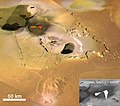English: NASA's Galileo spacecraft caught this volcanic eruption in action on Jupiter's moon Io on November 25, 1999. This mosaic shows Tvashtar Catena (now called
Tvashtar Paterae), a chain of calderas, in enhanced color. It combines low resolution (1.3 kilometers, or .8 miles, per picture element) color images of Io taken on July 3, 1999 with the much higher resolution (180 meters, or 197 yards, per picture element) black and white images taken in November. The molten lava was hot enough, and therefore bright enough, to saturate, or overexpose, Galileo's camera (original image is inset in lower right corner). The bright lava curtain (a chain of lava fountains) and surface flows shown in the color image were assembled as an interpretive drawing by Galileo scientists, based on their knowledge of how the camera behaves when saturated. The lava appears to be producing fountains to heights of up to 1.5 kilometers (5,000 feet) above the surface. Several other lava flows can be seen on the floors of the calderas. The darkest flows are probably the most recent.
The elongated caldera in the center of the image is almost surrounded by a mesa that is about 1 kilometer (.6 miles) high. In places the mesas margins are scalloped, which is typical of an erosional process called sapping. This occurs when fluid escapes from the base of a cliff, causing the material above it to collapse. On Earth, sapping is caused by springs of groundwater. Similar features on Mars are one of the key pieces of evidence that water flowed on Mars surface in the past. On Io, the fluid is believed to be sulfur dioxide, which should vaporize almost instantaneously when it reaches the near vacuum at Io's surface, blasting away material at the base of the cliffs.
North is to the top of the image and the Sun illuminates the surface from the lower left. The high resolution black and white image was taken at a distance of 17,000 kilometers (11,000 miles).
The Jet Propulsion Laboratory, Pasadena, CA manages the mission for NASA's Office of Space Science, Washington, DC. JPL is a division of the California Institute of Technology, Pasadena, CA.
This image and other images and data received from Galileo are posted on the Galileo mission home page at
http://galileo.jpl.nasa.gov. Background information and educational context for the images can be found at
http://galileo.jpl.nasa.gov/gallery/io.cfm.




